
100% vlna
od 98.00 Kč /50g
Cenu za klubka počítáme podle spotřeby při výrobě modelu v nejmenší velikosti a nejlevnější variantě příze. Rádi byste ještě lepší cenu? Třeba ji najdete mezi DROPS Deals!
Newport
DROPS pončo s pruhy háčkované shora dolů z příze "Big Merino". Velikost: S - XXXL.
DROPS design: model č. mb-027
Skupina přízí: C nebo A + A
----------------------------------------------------------
Velikost: S/M – L/XL – XXL/XXXL
Materiál:
DROPS BIG MERINO firmy Garnstudio
200-250-250 g, barva č. 01, smetanová
150-150-200 g, barva č. 19, béžová
150-150-200 g, barva č. 09, levandule
DROPS HÁČEK č. 5,5 – nebo velikosti potřebné k uháčkování zkušebního vzorku o rozměrech 13 DS x 8 řad = 10 x 10 cm.
-------------------------------------------------------
Náhradní příze – Podívejte se, jak změnit přízi
Skupina přízí A až F – Neměňte návod, změňte přízi
Spotřeba příze při použití náhradní příze – Využijte náš převodník
-------------------------------------------------------

100% vlna
od 98.00 Kč /50g
Cenu za klubka počítáme podle spotřeby při výrobě modelu v nejmenší velikosti a nejlevnější variantě příze. Rádi byste ještě lepší cenu? Třeba ji najdete mezi DROPS Deals!
- Česky
- Dansk
- Deutsch
- Eesti keel
- English (UK/cm)
- English (US/in)
- Español
- Français
- Íslenska
- Italiano
- Magyar
- Nederlands
- Norsk
- Polski
- Português
- Suomi
- Svenska
- English (UK/cm), Bulgaria
- English (UK/cm), Croatia
- English (UK/cm), Greece
- English (UK/cm), Latvia
- English (UK/cm), Lithuania
- English (UK/cm), Romania
- English (UK/cm), Slovenia
- Česky, Slovakia
Návod
Viz schéma A.2. Začátek kruhové řady leží za vzorem A.1. Kruhovou řadu končíme 1 pevným okem do 1./3. řo v kruhové řadě.
SLED PRUHŮ:
Pončo háčkujeme v barevných pruzích, viz č. 1-3 ve schématu.
Barva č. 1 = smetanová.
Barva č. 2 = béžová.
Barva č. 3 = levandule.
TIP - PŘIDÁVÁNÍ:
Přidáváme rozháčkováním 1 DS na dva (tj. do 1 DS uháčkujeme 2 DS).
----------------------------------------------------------
PONČO:
Háčkujeme v kruhových řadách shora dolů. Barvy střídáme dle SLEDU PRUHŮ – viz výše.
Háčkem č. 5,5 uháčkujeme smetanovou přízí 92-99-113 řo a spojíme je pevným okem do kroužku. Pak 1 DS do 1. řo, *1 řo vynecháme, po 1 DS do každého z dalších 6 řo*, *-* opakujeme = 79-85-97 DS. Pokračujeme takto: vzor A.1 (= 1 DS), vzor A.2 nad zbylými DS, začínáme 2. kruhovou řadou ze schématu (= v kruhové řadě máme 13-14-16 sekvencí vzoru). V řadách označených šipkou přidáme nad DS ve vzoru A.2 rovnoměrně 36-42-48 DS – viz TIP - PŘIDÁVÁNÍ, po každém přidávání háčkujeme o 6-7-8 sekvencí vzoru A.2 více (tj. po prvním přidávání háčkujeme 19-21-24 sekvencí vzoru A.2, po dalším přidávání háčkujeme 25-28-32 sekvencí vzoru A.2). Po dokončení 1 celé sekvence vzoru A.2 (na výšku) máme v kruhové řadě 151-169-193 DS. Uháčkujeme ještě 1 celou sekvenci vzoru A.2 (na výšku) a přidáváme stejně jako před tím = v kruhové řadě máme 223-253-289 DS. Nyní uháčkujeme ještě 0-1-2x posledních 5 kruhových řad vzoru A.2 (bez přidávání). Nakonec uháčkujeme první 4 kruhové řady vzoru A.2 a poté práci ukončíme.
LEM PRŮKRČNÍKU:
Smetanovou přízí uháčkujeme po 1 KS do každého řo z počáteční řetízkové řady. Pak práci ukončíme.
Schéma

|
= řo |

|
= KS do oka |

|
= KS mezi 2 DS |

|
= KS kolem řo |

|
= DS do oka |

|
= DS kolem řo |

|
= DS mezi skupinky DS |
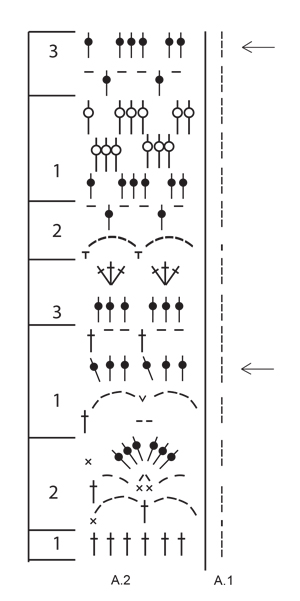
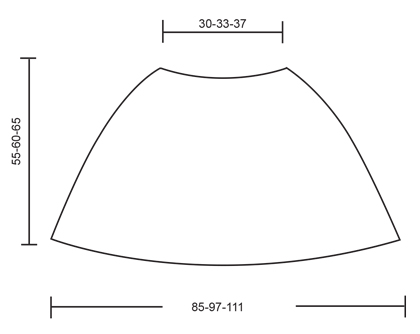
Jak můžete zacházet s našimi návody? Můžete sdílet DROPS návody online, s použitím původní fotky, uvedením originální příze, jména a čísla modelu. Ale JE ZAKÁZÁNO jakkoli reprodukovat či kopírovat celé návody v digitální podobě. Obchody s přízí mohou využívat databázi DROPS návodů k podpoře prodeje našich produktů. Návody si můžete vytisknout v libovolném počtu kopií. Žádáme vás o jedinou věc: nedělejte žádné úpravy a změny v tištěném originálu, ani původní návod v tištěné podobě nijak nedoplňujte. A také respektujte pravidlo DROPS a návody poskytujte klientům zdarma. Vydavatele, kteří by rádi zveřejnili naše návody v tištěných knihách nebo časopisech, prosíme, aby nás kontaktovali - rádi jim poskytneme podrobnější informace. Prodej výrobků vytvořených podle návodů DROPS je povolen pouze v případě, že jde o prodej jednotlivých kusů nebo výrobu na zakázku. Větší komerční využití návodů dovoleno není. U každého výrobku musí být rovněž jasně a zřetelně uvedeno, že jde o výrobek podle modelu z kolekce DROPS DESIGN. Opatřit nášivkami či visačkami oděvy, které využívají DROPS DESIGN je podmíněno uvedením následujícího textu: "Model DROPS DESIGN vytvořil/a...(doplňte jméno člověka, který oděv vyrobil)". Použití fotografií DROPS pro marketingové účely/prodej je povoleno výhradně v přímé souvislosti s použitím/prodejem přízí, pomůcek a doplňků DROPS. Fotografie nesmí být vystřižené, ořezané ani jinak upravené a logo na nich musí zůstat zřetelně viditelné.
Vyhrazujeme si právo kdykoli stáhnout povolení k užívání, a to bez udání důvodu.
Každý náš návod je doprovázen speciálními video-ukázkami, které vás navedou.
Tyto podrobné video-návody vás povedou "krok za krokem":
Proč je napětí příze u pletení/ háčkování tak důležité?
Napětí příze (hustota úpletu) určuje konečné míry vaší práce a obvykle se měří na vzorku 10 x 10 cm. Spočítáme takto: počet ok na šířku x počet řad na výšku - např.: 19 ok x 26 řad = 10 x 10 cm.
Napětí příze je velmi individuální; někteří lidé pletou/ háčkují volně, zatímco jiní značně utahují. Napětí příze přizpůsobíte změnou velikosti jehlic, proto doporučenou velikost jehlic berte pouze jako vodítko! Je důležité, abyste zajistili, že VAŠE napětí příze odpovídá napětí uvedenému ve vzoru. Pokud budete pracovat s jiným napětím příze než je uvedeno ve vzoru, vaše spotřeba příze a konečné rozměry vaší práce se budou lišit.
Napětí příze také určuje, které příze je možné vzájemně zaměňovat. Pokud dosáhnete stejného napětí příze, můžete snadno zaměnit jednu přízi za druhou.
Viz lekce DROPS: Jak změřit napětí příze/ zkušební vzorek
Viz video DROPS: Jak vypracovat zkušební vzorek napětí příze
Jak zjistím, kolik klubek příze potřebuji?
Požadované množství příze je uvedeno v gramech, např.: 450 g. Pro výpočet potřebného množství klubek musíte nejdříve vědět, kolik gramů je v 1 klubku (25 g, 50 g nebo 100 g). Tyto informace jsou dostupné po kliknutí na jednotlivé druhy přízí na našich stránkách. Vydělte požadované množství množstvím každého klubka. Pokud má například klubko 50 g (nejběžnější množství), výpočet bude následující: 450 / 50 = 9 klubek.
Mohu použít jinou přízi než jaká je doporučena u vybraného vzoru?
Při záměně jedné příze za druhou je důležité, aby napětí příze (hustota úpletu) při pletení/ háčkování zůstala stejná. To proto, aby rozměry hotového oděvu odpovídaly poskytnutému náčrtu. Stejného napětí příze je snazší dosáhnout pomocí přízí ze stejné skupiny. Je také možné pracovat s vícero vlákny tenčí příze najednou, a tak dosáhnout stejného napětí jako při práci se silnější přízí. Vyzkoušejte náš převodník přízí. Doporučujeme vám si vždy vypracovat zkušební vzorek (swatch).
POZNÁMKA: při záměně přízí se může oděv výrazně lišit od oděvu na fotografii, to díky rozdílným vlastnostem a složení každé příze.
Viz lekce DROPS: Mohu použít jinou přízi než je uvedena ve vzoru?
Co to jsou skupiny přízí DROPS?
Všechny naše příze jsou rozděleny do skupin přízí (od A do F) podle síly a napětí příze – skupina A zahrnuje nejtenčí příze a skupina F ty nejsilnější. Toto vám usnadní hledání alternativních přízí k našim vzorům, pokud byste chtěli přízi vyměnit. Všechny příze stejné skupiny mají podobné napětí příze (hustotu úpletu) a můžete je tak snadno vzájemně nahrazovat. Jednotlivé druhy přízí se nicméně liší složením a vlastnostmi, hotové dílo tak získá na jedinečnosti jak na pohled tak na omak.
Kliknutím zde zobrazíte přehled přízí v jednotlivých skupinách.
Jak použít převodník přízí (yarn calculator)?
V horní části všech našich vzorů najdete odkaz na náš převodník přízí (yarn calculator), což je užitečný nástroj, pokud byste chtěli použít jinou než doporučenou přízi. Vyplněním druhu příze, kterou si přejete vyměnit, množství (ve vaší velikosti) a počtu vláken, vám převodník nabídne vhodné alternativní příze se stejným napětím příze (hustotou úpletu). Dále vám prozradí, kolik alternativní příze budete potřebovat a zda budete muset pracovat s vícero vlákny najednou. Většina klubek má hmotnost 50 g (některá 25 g nebo 100 g).
Pokud je vzor vypracován ve vícero barvách najednou, bude nutné každou barvu vypočítat samostatně. Stejně tak, pokud je vzor vypracován s několika vlákny různých přízí (například 1 vlákno alpaky a 1 vlákno Kid-Silk), budete muset najít alternativy jednotlivě, tedy pro každou zvlášť.
Kliknutím zde zobrazíte náš převodník přízí
Proč u vzorů stále uvádíte příze, které se již nevyrábí?
Protože různé příze mají různé vlastnosti a textury, rozhodli jsme se původní přízi v našich vzorech zachovat. Můžete však snadno najít dostupné alternativy mezi našimi ostatními druhy přízí pomocí našeho převodníku nebo si jednoduše vybrat přízi ze stejné skupiny přízí.
Je možné, že někteří prodejci mají přízi stále na skladě, nebo že někdo má doma pár klubek, pro která by rád našel vzory.
Převodník přízí vám nabídne jak alternativní přízi, tak i její požadované množství.
Jakou mám zvolit velikost?
Pokud si nejste jistí jakou velikost vypracovat, můžete například změřit oděv, který již vlastníte a jehož velikost se vám líbí. Následně si zvolte velikost porovnáním těchto mír s těmi v tabulce velikostí vybraného vzoru.
Tabulku velikostí najdete ve spodní části vzoru.
Viz lekce DROPS: Jak číst tabulku velikostí
Proč mi nevychází velikost zkušebního vzorku na doporučené síle jehlic?
Velikost jehlic uvedená ve vzoru slouží pouze jako vodítko, důležité je dodržet napětí příze (hustotu úpletu). A protože napětí příze je velmi individuální, budete muset upravit velikost jehlic tak, abyste zajistili stejné napětí jaké je uvedené ve vzoru – možná budete muset přizpůsobit sílu jehlic o 1 či dokonce 2 velikosti abyste dosáhli správného napětí. Za tímto účelem vám doporučujeme vypracovat zkušební vzorky.
Pokud byste pracovali s jiným napětím příze než je uvedeno, rozměry hotového oděvu se mohou od rozměrů uvedených na náčrtu lišit.
Viz lekce DROPS: Jak změřit napětí příze/ zkušební vzorek
Viz video DROPS: Jak vypracovat zkušební vzorek
Proč je vzor vypracován shora dolů?
Práce s oděvem shora dolů poskytuje větší flexibilitu a prostor pro individuální úpravy. Například je snazší si oděv v průběhu práce vyzkoušet a také upravit délku sedla a průramků.
Návody vše pečlivě vysvětlují krok za krokem, ve správném pořadí. Schémata jsou přizpůsobena směru pletení a vypracována jako obvykle.
Jak správně číst schéma u pletení?
Schéma zobrazuje všechny řady/ kruhové řady, a každé oko jak se jeví při pohledu z lícové strany. Čte se zdola nahoru, zprava doleva. 1 čtvereček = 1 oko.
Při práci v řadách (tam a zpět) je každá lichá řada řadou lícovou a každá sudá řada je řadou rubovou. Při práci v rubových řadách je nutné vypracovávat schéma obráceně: zleva doprava, hladká oka pleteme obrace, oka pletená obrace vypleteme hladce atd.
Při práci v kruhových řadách je každá řada řadou lícovou a schéma je tedy ve všech řadách vypracováno zprava doleva.
Viz lekce DROPS: Jak číst schémata u pletení
Jak správně číst schéma u háčkování?
Schéma zobrazuje všechny řady/ kruhové řady, a každé oko jak se jeví při pohledu z lícové strany. Vypracovává se zdola nahoru, zprava doleva.
Při práci v řadách (tam a zpět) je každá lichá řada řadou lícovou a každá sudá řada je řadou rubovou. Při práci v rubových řadách je nutné vypracovávat schéma obráceně: zleva doprava.
Při práci v kruhových řadách je každá řada řadou lícovou a schéma je tedy ve všech řadách vypracováno zprava doleva.
Při práci s kruhovým schématem začínáme uprostřed a postupujeme směrem proti směru hodinových ručiček, řadu po řadě.
Řady obvykle začínají daným počtem řetízkových ok (ekvivalentní výšce následujícího oka), což bude buď znázorněno ve schématu nebo vysvětleno ve vzoru.
Viz lekce DROPS: Jak číst schémata u háčkování
Jak vypracovat několik schémat zároveň v jedné řadě/ kruhové řadě?
Pokyny pro práci s vícero schématy zároveň ve stejné řadě/kruhové řadě budou často popsány takto: „háčkujeme vzor A.1, A.2, A.3 celkem 0-0-2-3-4x". To znamená, že A.1 vypracujete jednou, následně A.2 vypracujete jednou a A.3 opakujete (na šířku) tolikrát, kolikrát je pro vaši velikost stanoveno – v tomto případě takto: S = 0 krát, M = 0 krát, L=2 krát, XL= 3 krát a XXL = 4 krát.
Se schématy se pracuje jako obvykle: začněte první řadou v A.1, poté vypracujte první řadu v A.2 atd.
Viz lekce DROPS: Jak číst schémata u pletení
Viz lekci DROPS: Jak číst schémata u háčkování
Proč jsou rukávy u větších velikostí kratší?
Celková šířka oděvu (od zápěstí k zápěstí) bude u větších velikostí větší, přestože rukávy jsou kratší. Větší velikosti mají delší průramky a širší náramenice, aby dobře seděly pro všechny velikostech.
Odkud měřím délku oděvu?
Rozměry na náčrtu/ schématu poskytují informace k celkové délce oděvu. Pokud se jedná o svetr nebo kabátek, délka se měří od nejvyššího bodu na náramenici nejblíže výstřihu směrem dolů ke spodní části oděvu. NENÍ měřeno od vrcholu ramene. Stejně se měří i délka sedla, od nejvyššího bodu náramenice dolů k místu, kde se sedlo dělí na trup a rukávy.
U kabátků, pokud není výslovně uvedeno jinak, se nikdy neměří délka na vnější straně légy. Vždy měřte délku na vnitřní straně.
Viz lekce DROPS: Jak číst schéma
Co znamená opakování?
Schémata se často opakují dokola nebo na výšku. 1 opakování na schématu tak, jak se jeví ve vzoru. Pokud je uvedeno vypracujte 5 opakování A.1 v řadě, pak vypracujete A.1 celkem 5 krát po sobě/ vedle sebe v jedné řadě. Pokud je uvedeno vypracujte 2 opakování A.1 svisle/ na výšku, vypracujte celé schéma jednou, následně začněte znovu od počátku následující řady a vypracujte celé schéma ještě jednou.
Proč je počet počátečních nahozených ok vyšší než počet, s kterým dále pracujeme?
Řetízková oka jsou o něco užší než sloupky. Abyste předešli příliš staženým okům nahozeného okraje, jednoduše uháčkujte více ok řetízku. Počet ok bude v následující řádě upraven tak, aby odpovídal vzoru a náčrtu.
Proč při práci shora dolů přidáváme oka pro pružný lem?
Pružný lem se oproti například lícovému žerzeji jeví mnohem staženější. Přidáním ok před vypracováním lemu se vyhnete viditelnému rozdílu v šířce přechodu mezi pružným lemem a zbytkem trupu.
Proč před uzavíráním lemu přidáváme oka?
Je snadné uzavřít lem příliš pevně. Nahazováním ok při uzavírání lemu (a současným uzavíráním těchto nahození) předejdete příliš utaženému okraji.
Viz video DROPS: Jak uzavřít pomocí nahození (yo)
Jak střídavě ujmout/ přidat v každé 3. a 4. řadě/ kruhové řadě?
Pro dosažení rovnoměrného přidání (nebo ujmutí) můžete přidat např.: každou 3. a 4. řadu střídavě takto: vypracujte 2 řady a přidejte v 3. řadě, vypracujte 3 řady a přidejte ve 4. Takto opakujte až po poslední přidávání..
Viz lekce DROPS: Přidávání či ujímání 1 oka střídavě v každé 3. a 4. řadě
Jak vypracuji kabátek v kruhových řadách namísto v řadách (tam a zpět)?
Pokud dáváte přednost práci v kruhových řadách namísto v řadách (tam a zpět), můžete samozřejmě vzor přizpůsobit a to tak, že přidáte můstky doprostřed přední části (obvykle 5 ok). Dále pak postupujete podle pokynů. Kde byste normálně otočili práci a pracovali z rubové strany, jednoduše pokračujete dál přes můstek v kruhových řadách. Nakonec kabátek rozstřihnete, naberete stehy pro vypracování légy a zakryjete rozstřižené okraje.
Viz video DROPS: Jak uplést a rozstřihnout můstek
Mohu vypracovat svetr v řadách (tam a zpět) namísto v kruhových řadách?
Pokud dáváte přednost práci v řadách (tam a zpět) namísto v kruhových řadách, můžete samozřejmě vzor přizpůsobit a to tak, že jednotlivé díly vypracujete samostatně a na konci je sešijete dohromady. Rozdělte počet ok trupu na polovinu, přidejte na každé straně 1 krajové oko (pro sešití) a vypracujte přední a zadní díl odděleně.
Viz lekce DROPS: Mohu vzor na kruhových jehlicích přizpůsobit rovným jehlicím?
Proč se popis vzoru mírně liší od modelu na fotografii?
Aby se zachovaly správné proporce, opakování vzoru se může v různých velikostech mírně lišit. Pokud nepracujete se stejnou velikostí v jaké je i oděv na fotografii, může se ten váš mírně lišit. Vzor byl pečlivě navržen a upraven tak, aby celkový dojem z oděvu zůstal stejný ve všech velikostech.
Dodržujte proto pokyny a schémata pro vaši velikost!
Jak změním oděv z dámské velikosti na pánskou?
Pokud jste našli vzor, který se vám líbí a který je k dispozici v dámské velikosti, není příliš těžké jej přizpůsobit velikosti pánské. Největší rozdíl bude v délce rukávů a trupu. Začněte pracovat na dámské velikosti o které si myslíte, že by seděla přes hrudník. Dodatečná délka bude vypracována těsně před uzavřením pro průramky. Pokud je vzor vypracován shora dolů, můžete přidat délku hned za průramky nebo před prvním ujmutím na rukávu.
Pokud jde o dodatečné množství příze, bude záležet na přidané délce, ale je lepší mít více klubek než-li méně.
Jak předejít línání u chlupatého oděvu?
Všechny příze mají přebytečná vlákna (z výroby), která mohou žmolkovat či odpadat. Česané příze (tj. chlupatější příze) mají více těchto volných, nadbytečných vláken, což způsobuje větší línání.
Línání také závisí na tom, co nosíme pod nebo přes oděv a zda to táhne vlákna příze. Není proto možné zaručit, že nedojde k žádnému línání
Níže je několik tipů, jak dosáhnout nejlepších výsledků při práci s chlupatější přízí:
1. Když je oděv hotový (než ho vyperete), silně s ním protřepejte, aby se volnější chloupky uvolnily. POZNÁMKA: NEPOUŽÍVEJTE čistící váleček na textil, kartáč ani jinou metodu, která tahá za přízi.
2. Oděv vložte do plastového sáčku a vložte jej do mrazáku – nízká teplota způsobí, že se vlákna k sobě méně přichytí a přebytečná vlákna se snadněji odloučí.
3. Ponechte několik hodin v mrazáku, než jej vyjmete a znovu protřepete.
4. Oděv perte podle pokynů na štítku příze.
Proč se na mé pletenině tvoří žmolky?
Žmolkování je přirozený proces, ke kterému dochází i u těch nejexkluzivnějších vláken. Je to přirozená známka opotřebení, kterému jde jen těžko předejít. Opotřebení je nejviditelnější v místech s vysokým třením, jako je podpaží či lemy.
Váš oděv může vypadat opět jako nový, když žmolky odstraníte pomocí kartáče na šaty nebo speciálního strojku - odžmolkovače.
Mezitím si můžete pročíst otázky a odpovědi, které k tomuto modelu položili ostatní, nebo navštívit skupinu DROPS Workshop na Facebooku, kde vám může poradit některá spřízněná duše!
Newport |
||||||||||||||||||||||
|
|
||||||||||||||||||||||
DROPS pončo s pruhy háčkované shora dolů z příze "Big Merino". Velikost: S - XXXL.
DROPS Extra 0-1309 |
||||||||||||||||||||||
|
VZOR: Viz schéma A.2. Začátek kruhové řady leží za vzorem A.1. Kruhovou řadu končíme 1 pevným okem do 1./3. řo v kruhové řadě. SLED PRUHŮ: Pončo háčkujeme v barevných pruzích, viz č. 1-3 ve schématu. Barva č. 1 = smetanová. Barva č. 2 = béžová. Barva č. 3 = levandule. TIP - PŘIDÁVÁNÍ: Přidáváme rozháčkováním 1 DS na dva (tj. do 1 DS uháčkujeme 2 DS). ---------------------------------------------------------- PONČO: Háčkujeme v kruhových řadách shora dolů. Barvy střídáme dle SLEDU PRUHŮ – viz výše. Háčkem č. 5,5 uháčkujeme smetanovou přízí 92-99-113 řo a spojíme je pevným okem do kroužku. Pak 1 DS do 1. řo, *1 řo vynecháme, po 1 DS do každého z dalších 6 řo*, *-* opakujeme = 79-85-97 DS. Pokračujeme takto: vzor A.1 (= 1 DS), vzor A.2 nad zbylými DS, začínáme 2. kruhovou řadou ze schématu (= v kruhové řadě máme 13-14-16 sekvencí vzoru). V řadách označených šipkou přidáme nad DS ve vzoru A.2 rovnoměrně 36-42-48 DS – viz TIP - PŘIDÁVÁNÍ, po každém přidávání háčkujeme o 6-7-8 sekvencí vzoru A.2 více (tj. po prvním přidávání háčkujeme 19-21-24 sekvencí vzoru A.2, po dalším přidávání háčkujeme 25-28-32 sekvencí vzoru A.2). Po dokončení 1 celé sekvence vzoru A.2 (na výšku) máme v kruhové řadě 151-169-193 DS. Uháčkujeme ještě 1 celou sekvenci vzoru A.2 (na výšku) a přidáváme stejně jako před tím = v kruhové řadě máme 223-253-289 DS. Nyní uháčkujeme ještě 0-1-2x posledních 5 kruhových řad vzoru A.2 (bez přidávání). Nakonec uháčkujeme první 4 kruhové řady vzoru A.2 a poté práci ukončíme. LEM PRŮKRČNÍKU: Smetanovou přízí uháčkujeme po 1 KS do každého řo z počáteční řetízkové řady. Pak práci ukončíme. |
||||||||||||||||||||||
Vysvětlivky ke schématu |
||||||||||||||||||||||
|
||||||||||||||||||||||

|
||||||||||||||||||||||

|
||||||||||||||||||||||
|
Vyrobili jste si tento nebo nějaký jiný z našich modelů? Přidejte ke svým fotkám na sociálních sítích tag #dropsdesign - díky tomu je uvidíme i my! Potřebujete s tímto návodem poradit?Otevřete-li si návod na stránce garnstudio.com, najdete tam výukových video-ukázek, Komentáře/Dotazy a další užitečné informace. © 1982-2024 DROPS Design A/S. Vyhrazujeme si veškerá práva. Tento dokument, včetně všech jeho dílčích částí, podléhá autorským právům. Podrobnější komentář k možnostem užití našich návodů najdete dole pod každým návodem na našich stránkách. |
||||||||||||||||||||||
V oblasti pletené a háčkované módy působí DROPS Design více než 40 let. Díky tomu vám můžeme nabídnout jednu z nejrozsáhlejších kolekcí modelů s bezplatnými návody dostupnými na internetu - navíc v 17 jazycích. K dnešnímu dni máme na 304 katalogů a 11422 návodů celkem - z nich je už 6300 dostupných v češtině.










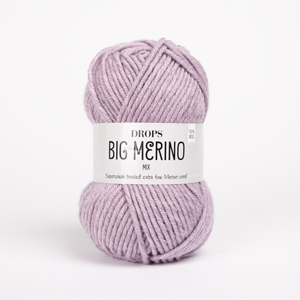
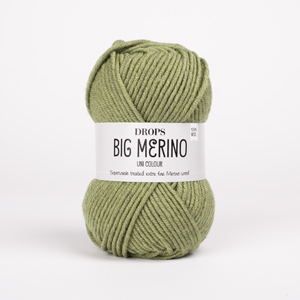
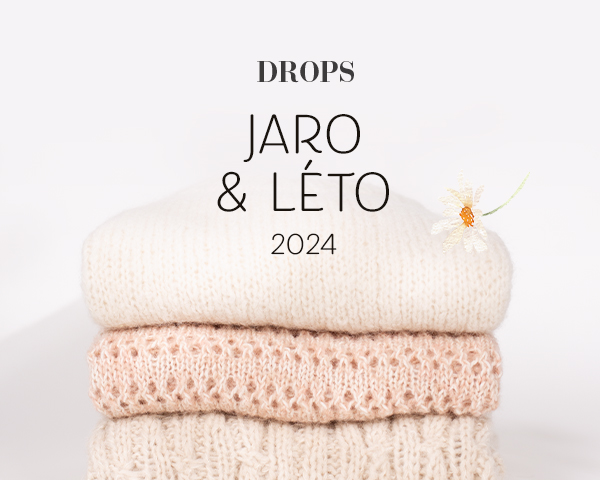





















Komentáře / Otázky (21)
In het patroon staat “ Meerder op de toer met een pijl 36-42-48 stk gelijkmatig over stk in A.2”. Helaas snap ik niet wat hier mee moet doen als ik het diagram bekijk. Kunt u mij verder helpen? Groeten, Mieke
01.04.2022 - 21:18DROPS Design answered:
Dag Mieke,
Op die toeren meerder je het aantal aangegeven steken , gelijkmatig verspreid over de toer. Je meerdert door 2 stokjes in 1 steek te haken.
04.04.2022 - 11:46Tusen takk for vennlig og lynraskt svar. Jeg har også et spørsmål til 3. siste og nestsiste rad i A2: I nestsiste rad sier diagrammet at det skal hekles staver i luftmasker. Men jeg ser ikke at det blir noen luftmasker å hekle dem i? Ifølge diagrammet skal det så vidt jeg forstår bare være staver i 3. siste rad i A. Så jeg valgte å sette stavene i nestsiste rad mellom stavgruppene (og det går jo bra). Men har jeg oversett / misforstått noe? Eller er symbolet feil?
18.01.2022 - 14:23DROPS Design answered:
Hei Lisen. Du har valgt helt riktig (hekle stav mellom hver stavgruppe siden det ikke er en luftmaske å hekle om). mvh DROPS Design
25.01.2022 - 10:25Hei Drops, tusen takk for alle deres fantastiske mønstre og ditto kundestøtte! Mitt spørsmål: Økning skal skje ved at det hekles to st i en. Men jeg skjønner ikke hvordan det skal la seg gjøre her? Bir det ikke bare å slå ekstra staver rundt lm-buene?
16.01.2022 - 10:52DROPS Design answered:
Hei Lisen. Jo, her burde øketipset vært omformulert til at det økes ved å hekle 1 ekstra stav om luftmasken / luftmaskebuen. Eller bare å fjerne øketipset, som vi når har gjort. Takk for at du gjorde oss oppmerksom på dette. mvh DROPS Design
18.01.2022 - 09:49Bonjour merci pour votre retour. Cependant, ce n'est toujours pas clair parce que vous dites qu'il faut crocheter soit 3 soit 4 brides dans chaque arceau. Or avec un départ de 79 brides, il n'y a que 26 arceaux. Donc si on augmente d'une bride dans chaque arceau, on n'augmente que de 26 brides au lieu de 36. Donc pour chaque arceau, il faut augmenter d'une ou de deux brides et on aura soit 4 ou 5 brides par arceau? Ca fait quand même une fameuse augmentation pour un rang.
10.06.2021 - 17:09DROPS Design answered:
Bonjour Romane, tout à fait, dans ce cas, si vous comptez par arceau, vous aurez 1 bride de A1. + 10 fois 5 brides + 16 fois 4 brides dans chacun des arceaux de A.2 - crochetez ainsi alternativement 4 ou 5 brides autour de chacun des arceaux en les espaçant à intervalles réguliers. Bon crochet!
11.06.2021 - 07:52Bonjour, Y aurait-il moyen que vous fassiez un tutoriel vidéo pour les premiers rangs, et surtout pour le rang d'augmentation? Merci d'avance,
10.06.2021 - 11:39DROPS Design answered:
Bonjour Romane, cette leçon explique comment répartir des augmentations, autrement dit, aux rangs indiqués par une flèche, vous crochèterez soit 3 brides dans chaque arceau (= comme dans le diagramme), soit 4 brides (= 1 augmentation). Est-ce plus facile à comprendre ainsi? Bonne continuation!
10.06.2021 - 13:24A1 means chain in each round? Why do we need it?
27.11.2020 - 13:15DROPS Design answered:
Dear Oshrat, A.1 indicates the beginning of each round. It may start with 1 chain or 3 chains (= 1 treble stitch). Happy crocheting!
29.11.2020 - 18:46I'm having trouble doing the first row. Am I supposed to make one chain between the six dc block ???
14.06.2020 - 01:04DROPS Design answered:
Dear Claudia, to avoid a tight edge and since the foundation chain is often quite too tight, you crochet here more chains than you need sts on first round, and, on first dc round you will skip 1 chain after every 6 trebles so that you get the correct number of sts/width at the end, just skip every 7th chain as explained and check/keep your tension. Happy crocheting!
15.06.2020 - 09:24In the row of first increase, i am not getting 19 repetitions i did increase in each diuble croxhet of the row before (12 dc), i get 13 repetitions not 19 what am i doing wrong??
09.09.2019 - 20:08DROPS Design answered:
Dear Amany, before the first increase you should have 13 repeats in width, on first increase row you should have 6 dc in each A.2 but you have to increase evenly 36 dc (read how to increase evenly here ) = 115 dc in total, ie you have now enough stitches to work 19 repeats of A.2. Happy crocheting!
10.09.2019 - 08:47Buongiorno. Come si fa a lavorare 2 m.a. in 1 m.a. nei giri indicati dalla freccia se nel.giro prima non ci sono maglie alte? Grazie
26.06.2019 - 14:15DROPS Design answered:
Buongiorno Monica. Lavora a intervalli regolari 1 maglia alta in più negli archi di catenelle. Buon lavoro!
26.06.2019 - 15:14Bonjour pouvait vous me détailer le chema mieux merci
25.03.2019 - 12:47DROPS Design answered:
Bonjour Mme Potier, vous trouverez ici quelques indications complémentaires sur la lecture des diagrammes. Bon crochet!
25.03.2019 - 13:17